The Top 7 Parlor Guitars – The Best Blues Boxes!
We may also earn commissions on purchases from other retail websites.
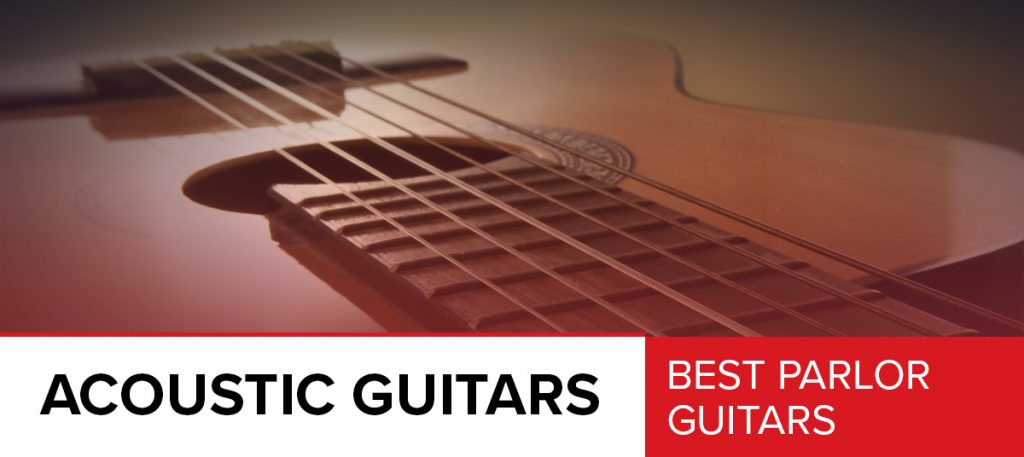
Last Updated: November 19, 2019
In our latest visit to this page we decided to refresh our chart a little to remove two parlor guitars that were proving difficult to find – the Simon & Patrick Woodland Pro Parlor and Oscar Schmidt O315. In their place came two new parlors to the market, comprising the limited-edition Gretsch G5021E and the solid Yamaha CSF1M.
Before you say it – no, parlor guitars are more than simply ‘small guitars’. Born in the late 19th century, parlor guitars (sometimes spelled ‘parlour’) have been a staple of folk and blues music for well over a hundred years, deservedly earning the nickname ‘blues boxes’ due to their typically boxy tone.
Even though the parlor’s popularity waned from the 1950s onwards, there is still demand for this specific style of acoustic guitar, particularly among blues and folk players, as well as beginners and guitarists who simply want a smaller guitar to keep around the house for when inspiration strikes.With so many parlor guitars around we have decided to highlight seven popular models in the chart below to help make your decision a little easier. These models reflect the current market and span several different price categories, as well as offering both vintage-inspired and modern takes on this unique style.
So, whether you are a beginner or an experienced delta blues player, it’s time to dive into parlor heaven!
Top 7 Best Parlor Guitars:
| Image | Acoustic Guitar / Rating | Summary | Check Price |
|---|---|---|---|
+ -  | Blueridge BR-341 Historic Series Total of 4.93/5 | Combination of vintage sound and modern features. | |
+ - 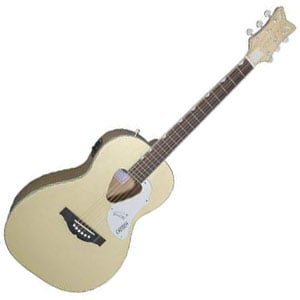 | Gretsch G5021E Total of 4.70/5 | A glitzy one-of-a-kind parlor from Gretsch. | |
+ - 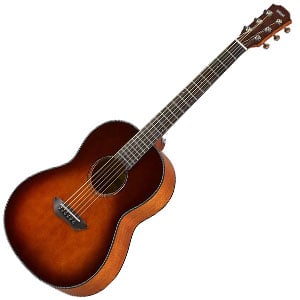 | Yamaha CSF1M Total of 4.72/5 | A new electro-acoustic parlor set to become a modern classic. | |
+ -  | Gretsch G9500 Jim Dandy Total of 4.58/5 | Revamped version of a very special guitar for a whole generation. | |
+ - 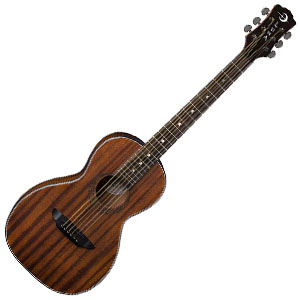 | Luna Gypsy Muse Parlor Total of 4.67/5 | Unique style from the popular budget brand. | |
+ - 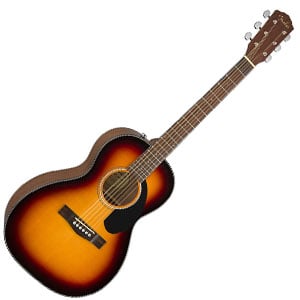 | Fender CP60S Total of 4.65/5 | Classic Fender style and sound from this petite parlor. | |
+ - 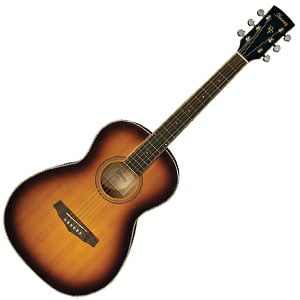 | Ibanez PN15 Total of 4.60/5 | Impressive entry-level offering from Ibanez. |
Blueridge BR-341 Historic Series
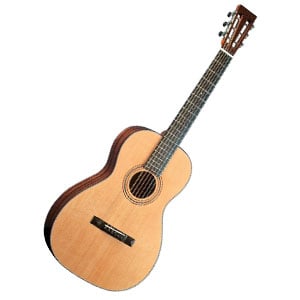
| Body And Neck: |  |
| Hardware: |  |
| Sound: |  |
| Value: |  |
Topping this chart is the exceptional BR-341 from Blueridge, which marries the sound and style of a vintage parlor with modern craftsmanship and playability. This is an all-solid-wood parlor guitar crafted with Sitka spruce on the top along with mahogany on the back and sides, leading to a clean, rich and well-balanced tone.
Other appointments worth noting is the sleek mahogany neck, the premium ebony fretboard and the vintage-style slotted headstock with a set of open-geared Gotoh tuners.
Of course, such quality comes at a price and – while not overly expensive – this instrument comes in at the higher end of the mid-range, so is best-suited for intermediate and experienced players. There’s more on the BR-341 in the full review .
Gretsch G5021E

| Body And Neck: |  |
| Hardware: |  |
| Sound: |  |
| Value: |  |
There are a few things that Gretsch loves to do – combine retro style with striking looks, and then make it a limited-edition model. That’s pretty much exactly what the iconic brand has done with the G5021E parlor!
This electro-acoustic certainly catches the eye, with a sparkly Casino Gold finish on the body and neck, along with silver sparkle binding and a distinctive headstock, soundhole and pickguard. It’s safe to say it’s one of a kind!
However, this parlor is also built to perform, with a solid spruce/laminated maple construction leading to a rich and bright unplugged tone, along with quality Fishman electronics when you plug in. We have more on the Gretsch G5021E in the full review!
Yamaha CSF1M

| Body And Neck: |  |
| Hardware: |  |
| Sound: |  |
| Value: |  |
A new addition to both the parlor guitar market and this chart is the CSF1M from Yamaha’s new CSF Series. As discussed in the main review of the CSF1M, this affordable midrange acoustic shows off simple but stylish looks, a stellar sound and a few extras that bump up the value.
It’s fundamentally a solid guitar, with a 23.6” scale length and sleek nato neck making it incredibly playable. The CFS1M features a solid spruce top with laminated mahogany back and sides, available in either a natural or smoky brown finish.
Not that you’d know it from looks alone, but this parlor is also an electro-acoustic, with a stealthy SRT Zero-Impact piezo pickup under the hood. One of our new favorites!
Gretsch G9500 Jim Dandy
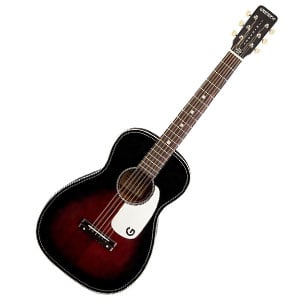
| Body And Neck: |  |
| Hardware: |  |
| Sound: |  |
| Value: |  |
If you’re looking for an affordable vintage acoustic, this gorgeous guitar delivers. The modern G9500 Jim Dandy from Gretsch stays true to the classic Rex parlor guitars of the 30’s, with its two-color sunburst parlor body, featuring an X-braced agathis top, back and sides.
There’s a semi-glossed steel-reinforced nato neck, which is slightly shorter than others and has an easy playing C shape, and a rosewood fretboard with 18 frets. With screened white binding, purfling and rosette, this retro beauty looks great and sounds the part too, with a warm tone that’s perfect for blues and fingerstyle players.
For the avid fan of vintage acoustic tones, this budget Gretsch is the best thing to get you started – as we highlight in the full review of this great guitar.
Luna Gypsy Muse Parlor

| Body And Neck: |  |
| Hardware: |  |
| Sound: |  |
| Value: |  |
Another affordable model comes in the shape of this petite all-mahogany parlor from Luna Guitars. At under $200, this is an all-laminate entry-level model, but one which really impressed in terms of both design and tone.
In particular, the detailing on the top and along the fretboard, giving this parlor a distinct look, although one that keeps it in line with the rest of Luna’s popular Gypsy Muse Series. But it’s not just a pretty face, with a robust build, a sleek satin finish and decent hardware.
There are higher-end parlors on this list, but for one that comes in at such a good price, you can’t help be persuaded by the Luna Gypsy Muse Parlor as we mention in the complete review.
Fender CP60S

| Body And Neck: |  |
| Hardware: |  |
| Sound: |  |
| Value: |  |
Fender’s newer CP60S takes the place of the earlier CP-100 in Fender’s acoustic lineup and it’s a welcome change, as several upgrades make the CP60S a very tempting prospect for beginners – especially at such a wallet-friendly price.
Available in two finishes (either natural or a vintage sunburst), the CP60S boasts a solid spruce top paired with laminated mahogany on the back and sides. The neck is also mahogany and features a rolled rosewood fretboard, which feels great in the hands.
While design and playability are notable, the tone is also very impressive for such a small and affordable parlor – well-balanced and projects nicely, as we highlight in the complete CP60S review.
Ibanez PN15

| Body And Neck: |  |
| Hardware: |  |
| Sound: |  |
| Value: |  |
As usual, Ibanez push the boat out by combining solid style, build, tone and playability for a price that will make you go, ‘Wait… how much?’. The PN15 is slightly larger than a typical parlor guitar and does the basics well, offering an all-laminate spruce and sapele body with a glossy warm sunburst finish.
The fit and finish is great and playability is solid, although best-suited for strummers, with a relatively narrow mahogany neck, with an 18-fret nandu fretboard.
Ibanez adds some decent hardware for the entry-level price, with a set of Advantage bridge pins, chrome tuners, and Ivorex II nut and saddle. There’s more on the Ibanez PN15 in the complete review.
What is a Parlor Guitar?
Parlor guitars are rooted in the late 19th century, where they emerged as a popular guitar style due to their compact size. Because they were so petite, they made perfect instruments for playing in reception rooms (known as ‘parlors’). Of course, the name stuck.
A parlor guitar is quite hard to define, as there is no exact standard for each one. As you may have seen in our chart, every brand and luthier has their own take on things. However, there are a couple of similarities which makes it quite easy to identify a parlor.
While there are no standard dimensions, it is agreed that a parlor should be small and compact – making it comfortable to hold and play in a living room or when sitting on the porch. Some players consider having the lower bout measure under 13.5” qualifies as a parlor, which we would agree with.
However, before you get your tape measure out, you can often identify a parlor guitar from looks alone. They tend to have an elongated body, which makes them look a little out of proportion when compared to ‘normal’ guitar shapes (such as a dreadnought or concert). This was because luthiers wanted to make the soundboard bigger to give the small guitar more of a voice.
Who Would Want a Parlor Guitar?
Everybody can appreciate the size of a parlor guitar – particularly smaller players and children who may struggle with bigger acoustic shapes such as jumbos or dreadnought guitars (for more on those styles, check out our article on the different kinds of acoustic guitar shapes. Parlors may also appeal to players who want a smaller guitar to keep around the house or on the porch, while they also make for excellent travel guitars.
However, pretty much anyone can play one as parlors tend to offer a standard nut width, making them suitable for all styles of playing, from strumming and flatpicking to fingerstyle.
While the size makes them suitable for many players, the tone of a parlor guitar is more of an acquired taste. They are tonally quite light, focused and well balanced, although with a big emphasis on the midrange. A parlor also traditionally offers a ‘boxy’ sound, which will appeal to vintage blues, folk and slide guitar players.
Due to the smaller build, a parlor guitar is certainly more of a practice and solo performance guitar (play a parlor alongside a jumbo and it may be overshadowed). With this in mind, it is easy to see why parlors are popular with singer-songwriters – the lighter projection means they don’t have to compete with the guitar when singing while playing.
The Final Word
We have highlighted a good handful of excellent parlor guitars, which hopefully goes some way to demonstrating that this historic style of compact guitar is still alive and well in the modern guitar world.
To help keep up with the times, some manufacturers have adapted to provide parlors that now offer bigger projection and easier playability, while retaining the convenient small body and focused tone.
Whether you are buying or just browsing, we hope this article has provided you with a little inspiration. Remember, if you are looking for a small guitar to take with you on the road, we also have an article dedicated to 3/4 sized guitars.


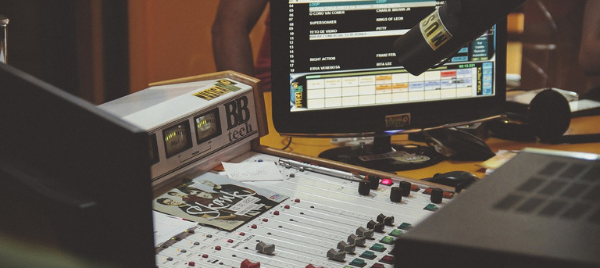
Reader Interactions